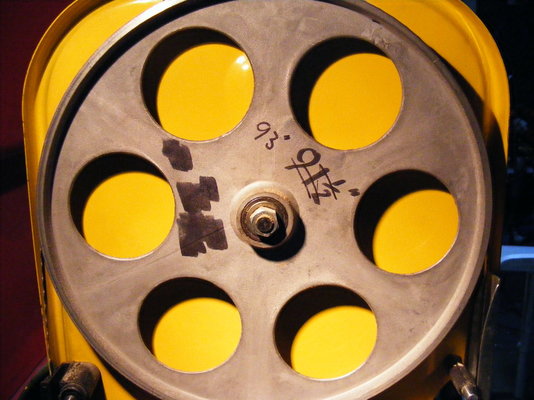Im sorry - bandsaw setup is all over the archives (i have looked) but still im unsure.
I have a warco 14 bandsaw. Same unit as branded under jet, nutool, etc.
It rips in pretty straight lines (which is what i want) but those lines are at an angle to the table.
I suspect this has to do with the blade being too far forward of the top wheel crown, however, if i tilt the blade further back, it starts to rub against the back of the wheel enclosure. I dont know if the unit has taken a knock at some point prior to my ownership, or if it was always like that.
This is a saw (not mine) just to illustrate -

The top of the wheel starts to scuff the inside of the cover, as the blade is tilted to track the blade further back.
Im wondering about taking off the guard, and shimming it so as it tilts, but...
My real question is as to rip fences.
Do the cheap ones have adjustment to make them parallel to the blade in the direction of cut, or is it just assumed that the front edge of the table will be perpendicular to the cut?
Ie if i dont resolve the issue, can i just set up the rip fence parallel to the blade, rather than the leading edge of the table?
I was looking at the cheap axminster one (£15 or so) -

....but it looks like the mounting to the table is all wrong for my saw anyhow.
Price then jumps to £100 for one of these -

...i really wasnt wanting to spend that much.
But am i understanding the crown issue. Id have thought that if i run the blade further back, the angle will change, but is this so insignificant that i will still need to set the fence at an angle to the table?
Thank you.
I have a warco 14 bandsaw. Same unit as branded under jet, nutool, etc.
It rips in pretty straight lines (which is what i want) but those lines are at an angle to the table.
I suspect this has to do with the blade being too far forward of the top wheel crown, however, if i tilt the blade further back, it starts to rub against the back of the wheel enclosure. I dont know if the unit has taken a knock at some point prior to my ownership, or if it was always like that.
This is a saw (not mine) just to illustrate -

The top of the wheel starts to scuff the inside of the cover, as the blade is tilted to track the blade further back.
Im wondering about taking off the guard, and shimming it so as it tilts, but...
My real question is as to rip fences.
Do the cheap ones have adjustment to make them parallel to the blade in the direction of cut, or is it just assumed that the front edge of the table will be perpendicular to the cut?
Ie if i dont resolve the issue, can i just set up the rip fence parallel to the blade, rather than the leading edge of the table?
I was looking at the cheap axminster one (£15 or so) -

....but it looks like the mounting to the table is all wrong for my saw anyhow.
Price then jumps to £100 for one of these -

...i really wasnt wanting to spend that much.
But am i understanding the crown issue. Id have thought that if i run the blade further back, the angle will change, but is this so insignificant that i will still need to set the fence at an angle to the table?
Thank you.



































